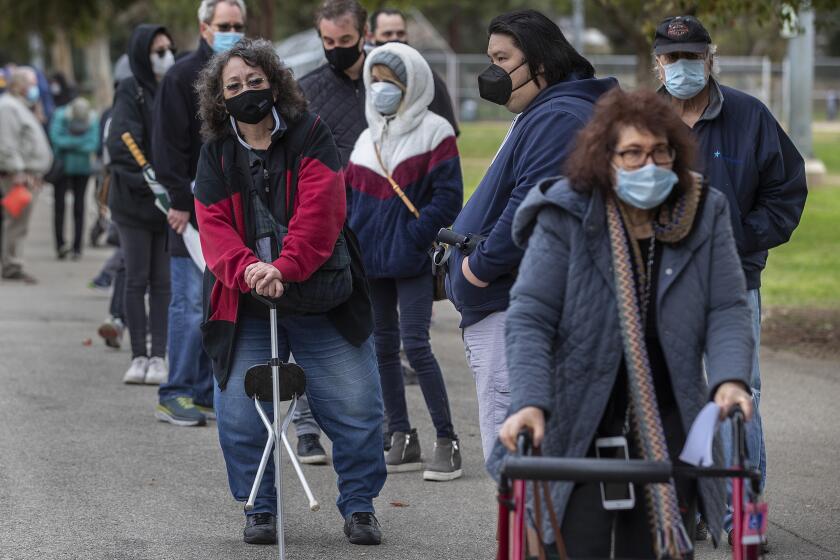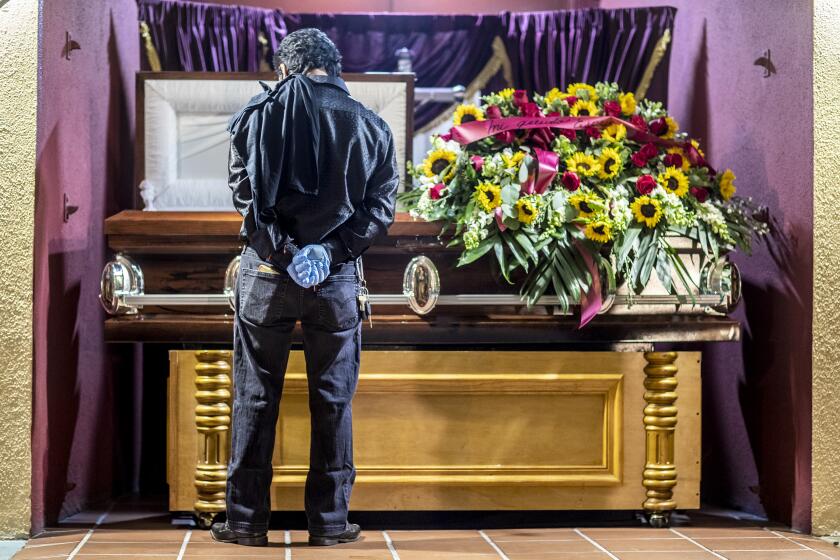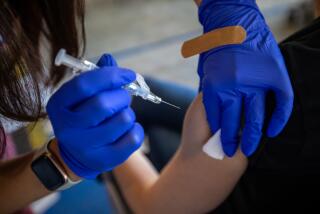Deadliest days of the pandemic: COVID-19 kills nearly 15,000 in California in January

More Californians died of COVID-19 in January than any other month of the pandemic, data from The Times tracker show, with L.A. County continuing to bear the brunt of the virus’ toll.
In the first month of 2021, 14,940 people lost their lives to the disease in California, bringing the state’s death toll close to 41,000, signifying that at least 1 in every 1,000 Californians has been killed by COVID-19.
In Los Angeles County, 6,411 people died in January — 137% more than the previous most-deadly month of December, in which 2,703 people died. To date, more than 17,000 Angelenos have died of the disease, a milestone the county surpassed Tuesday.
The record-breaking number of deaths comes despite a downward trend in coronavirus cases and hospitalizations, as well as growing vaccinations in Los Angeles County.
Currently, only about 2,700 deaths separate California and New York, where just over 43,600 people have died of the illness since the start of the pandemic, according to data from Johns Hopkins University. But New York saw its peak in April, while California is still reeling from a surge that began in late November.
Calling it a “critical moment in the pandemic,” L.A. County Public Health Director Barbara Ferrer said Monday it was important that the public not relax, even though some numbers have improved and restrictions have been lifted.
“It is … time to remain super-vigilant against this deadly virus and continue to stay home as much as possible,” Ferrer said. “It’s only by the actions that each business and each individual in L.A. County takes that we’re going to see this continued reduction in transmission.”
The L.A. County surge peaked in early January, Ferrer said, after which the average number of daily deaths from COVID-19 dropped by about 33%. But, she noted, it was “really only a very small decline” when compared to the 1,400% increase in deaths that overtook the county during December and January.
“Any additional surge in cases would require us to take a step backward in our recovery journey, and that is something that none of us wants,” Ferrer said. “We’re still living through the nightmare of a surge.”
San Diego County has California’s largest cluster of known cases of B.1.1.7.
Nationwide, the numbers are similarly grim: More than 95,000 people in the U.S. died from COVID-19 in January, surpassing December’s previous high of just over 77,000. More than 441,000 people have died nationwide since the first cases of COVID-19 were reported just over a year ago.
Yet Los Angeles County continues to suffer disproportionately: According to Johns Hopkins, L.A. has recorded more deaths than any other county in the U.S. Chicago’s Cook County is a distant second with 9,420 deaths.
L.A. County is now averaging about 6,200 new coronavirus cases a day over the last week, significantly below the average of about 15,100 new cases a day recorded in early January, but still much higher than the daily average of less than 1,000 new cases a day in mid-October.
The number of people hospitalized for COVID-19 is now about 5,300, the lowest since mid-December. COVID-19 hospitalizations peaked in L.A. County on Jan. 5, topping out at 8,098, but they are still far higher than in early October, when there were fewer than 700 COVID-19 patients in hospitals in the county.
The average daily number of COVID-19 deaths is still high in L.A. County — about 215 deaths a day over the past week. The peak daily average was 241, recorded for the seven-day period that ended Jan. 14.
A Times analysis found that in January, there were 63.5 deaths per 100,000 residents in L.A. County. Statewide, the rate was 38.2.
Of great concern to officials is the emergence of the B.1.1.7 variant, which has kept the county on high alert. Officials with the L.A. County Department of Public Health on Saturday confirmed the second case of the U.K. variant, which is more transmissible and may be deadlier than the more common variety of the coronavirus.
The B.1.1.7 variant, first identified in Britain, is not believed to be a dominant strain in L.A. County, but officials and experts in San Diego County have warned its emergence there could plausibly overwhelm hospitals if people decide to stop wearing masks and physically distancing as they did in the weeks prior to Thanksgiving.
Officials are urging residents and businesses to remain vigilant about personal protective actions and safety measures.
“Because some sectors have reopened, it doesn’t mean that the risk for community transmission has gone away,” Ferrer said in a news release. “It hasn’t, and each of us needs to make very careful choices about what we do and how we do it. This virus is strong, and we are now concerned about variants and what these will mean in our region.”
L.A. County and California are seeing promising declines in coronavirus cases and hospitalizations, but progress remains precarious and could be eroded, officials say.
Public health officials announced the first confirmed case of the U.K. COVID-19 variant in the county Jan. 16. Days later, a second, “homegrown” strain, B.1.426, was found to account for nearly a quarter of 4,500 viral samples gathered throughout California in the last weeks of 2020.
In addition, four new cases of multisystem inflammatory syndrome in children were reported by health officials Saturday, bringing the total cases of MIS-C in L.A. County to 66 children, including one death.
MIS-C is an inflammatory condition associated with COVID-19. Symptoms include a fever that doesn’t go away, and inflamed body parts including the heart, lungs, kidneys, brain, skin, eyes or gastrointestinal organs.
All 66 children with MIS-C in L.A. County were hospitalized, officials said, and 44% were admitted to intensive care. Of those infected, 32% were younger than 5; 38% were ages 5 to 11; and 30% were ages 12 to 20.
Latino children have accounted for nearly three-quarters of the reported MIS-C cases, continuing the frighteningly high levels of COVID-19-related illnesses among the county’s Latino population.
The death toll among Los Angeles County’s Latino residents is nearly triple that of white residents, data show.
“There is deep sorrow, sadness and loss in our county as a result of COVID-19,” Ferrer said. “Although some restrictions were just lifted in our county, we are still in a very dangerous period in terms of cases, hospitalizations and deaths.”
The last time hospitals were able to offer their full range of services was at the beginning of November, when there were fewer than 900 COVID-19 patients in L.A. County facilities, Ferrer said Monday, adding: “While we’re headed in the right direction, we still again have a ways to go before our hospitals are not overcrowded and healthcare workers are not stressed.”
The latest data show that the most recent surge was again driven by younger adults but caused the greatest hospitalizations and deaths among the most elderly residents.
Among a sample of patients hospitalized for COVID-19 from August through December, 43% were 65 or older and 86% had at least one underlying health condition. Two out of every three hospitalized patients were overweight or obese; 41% had Type 2 diabetes and almost two-thirds had cardiovascular disease.
“These numbers are stark reminders of the risk of serious illness amongst older adults and people with underlying health conditions,” Ferrer said. “Many, many people in L.A. County fall into one or more of these risk groups, and we all must do our very best so that we’re protecting them.”
Meanwhile, vaccination efforts continue in the county, despite a rocky start and an anti-vaccination demonstration that deterred operations at Dodger Stadium over the weekend. Officials on Monday criticized protesters who blocked access to people trying to get vaccines.
“I was very upset and disheartened,” L.A. County Supervisor Hilda Solis said of the disruption to the vaccination efforts.
Solis said authorities will set up space for protesters in the future who can share their viewpoints but “won’t disrupt” the traffic flow.
”I understand people have 1st Amendment rights. … But when you become disruptive and actually create more problems through congestion, traffic jams or hostility in a manner that is not conducive, then I would want to have our public safety officials involved and to be there to protect all that are involved,” Solis said.
To date, more than 886,000 doses of the two types of COVID-19 vaccines have been administered across the county, according to The Times vaccination tracker.
“L.A. County has administered more doses of vaccine today than any other large county or large city in the United States, and we have the highest percent administration rate,” Ferrer said.
But the shipments have been inconsistent. For the week of Jan. 11, L.A. County received 193,950 vaccine doses; the following week, it received only 168,575 doses and only 146,225 doses the week after that.
“The pace of vaccinations remains very slow because of the limited supply,” Ferrer said, adding that second doses are currently being prioritized among the region’s residents.
More to Read
Sign up for Essential California
The most important California stories and recommendations in your inbox every morning.
You may occasionally receive promotional content from the Los Angeles Times.
















